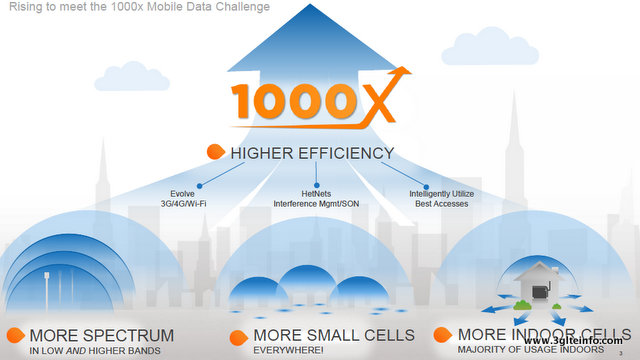Mobile data rate is never at its peak in the history and it won’t be sufficient anytime soon in near future. GPRS, EDGE, 3G, HSDPA, HSPA+, LTE or LTE-Advanced none of these technology will ever will make the data hungry mobile devices happy. Why because it’s a never-ending story.
I was watching a football world cup qualifier match two days ago at Malmo stadium between Sweden and Kazakhstan and trying to update my status on Facebook. This was the most horrible experience I have with mobile communication till now. Till the end of the game I could not access network. I was using my Samsung Galaxy S III which is a HSPA+ (42 Mbps) modem inside but that was not enough to get some basic data connectivity.

Yesterday evening I got this awesome white paper from Qualcomm called “1000X Mobile Data Challenge”. The presentation is all about making the present and future wireless network more efficient to get best throughput. Here is a small excerpt from the whole presentation.
The main areas where wireless infrastructure can be improved is broadly divided into:
- More spectrum
- More small cells
- More indoor cells.
More Spectrum
Analysts predict that the mobile broadband traffic will double every year. According to a ITU study Europe will need 1.7 GHz of spectrum by 2020, which is double the amount currently allocated.
Spectrum is a rare resource and the only way to use it is getting the best out of it. All the underutilized spectrum should be used efficiently.
New policies like ASA (Authorized Shared Access) can help to use unused spectrum. ASA takes advantage of the Cognitive Radio techniques that were originally developed for the unlicensed TV White Space and uses them to facilitate sharing in a given spectrum band by multiple licensed networks
Because the spectrum is licensed, ASA licensees can ensure spectrum access and they can allocate capital to build network infrastructure
- Since ASA spectrum is licensed, it becomes possible for the ASA network to provide predictable quality of service (QoS)
- 3G/4G Mobile Broadband Networks Using ASA: macro cells, pico cells, femto cells
- Support for FDD and TDD
- Support for Carrier Aggregation
- Additional carrier can utilize ASA spectrum to provide increased capacity
- ASA Macros can be deployed in key cities where additional citywide capacity is needed
- Pico cells can be deployed at key areas where additional capacity is needed Current Pico cells use traditional licensed spectrum. New ASA Pico cells can provide additional capacity using ASA spectrum in addition to traditional licensed spectrum
More Small Cells and Indoor Cells
Small cells like macro, pico, femto will definitely going to open up any new opportunities in the future.
Macro : Conventional base stations that use dedicated backhaul and open to public access. Typical transmit power ~43 dBm; antenna gain ~12-15 dBi.
Pico: Low power base stations that use dedicated backhaul connections and open to public access. Typical transmit power range from ~ 23 dBm-30 dBm, 0-5 dBi antenna gain;
Femto: Consumer-deployable base stations that utilize consumer’s broadband connection as backhaul; femto base stations may have restricted association. Typical transmit power < 23dBm.
Relays–base stations using the same spectrum as backhaul and access. Similar power as Pico’s.
Heterogeneous Network: A deployment that supports macros, picos, femtos and relays in the same spectrum. HetNet is a big way to reduce load from big cells but the biggest disadvantage is interference. With better interference management HetNet will definitely help.
Will these steps help me update my Facebook status next time?

Permalink
Well i doubt doing doing all this will help to update the Facebook page. Your problem is not any of these things above. It is a usual problem of a Large number of accesses made in a smaller dense area. A stadium is a perfect example of this where thousands of people are camped on to same group of cells and hence if every time an event happens (like a goal etc) everybody tries to access the FB same time which results in RACH failure. This can be resolved with only good network planning (Like having Macro cell and then redirection to neighboring cells for service etc). Hope this helps.
Permalink
Macro cell is one way to solve this issue. But the future is not what we are experiencing today. There will be lot of network congestion. Qualcomm approach on this is to have smaller cells and better load balancing.
Permalink
Permalink